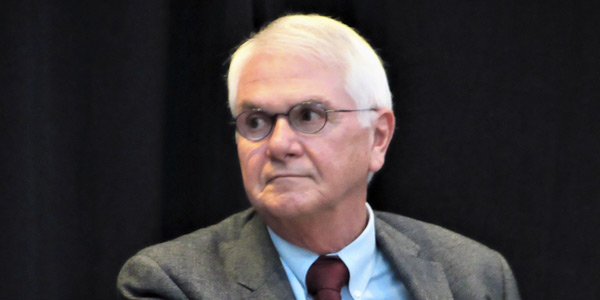By Amanda Durish Cook
BRANSON, Mo. — Energy industry veterans mused on the state of energy innovation and the future of the sector during a panel discussion at MISO’s annual stakeholders’ meeting last week.

Voss | © RTO Insider
Thomas Voss, retired chairman of Ameren and a self-proclaimed devotee of innovation, said microgrids and rooftop solar are gaining traction.
“In California, it’s completely changed the planning process. Lines that they thought would be overloaded were fine because of rooftop solar,” Voss said during the June 21 panel. “Now there’s winner and losers, and it might not be as fair as it should be, but hopefully we can come together and solve that.”
William Mohl, a former Entergy executive, said MISO has the luxury of studying what the RTOs on the coasts are doing with renewables and storage and waiting until it becomes economic to implement the results.
James Jura, former CEO of Associated Electric Cooperative Inc., recounted how he used to ask industry participants if they had heard of Elon Musk before he was a household name: “I said, ‘You have to look him up because he’s going to get between you and your member-owners.’”
Libby Jacobs, former chair of the Iowa Utilities Board and former Organization of MISO States president, said FERC will need to address the public appetite for renewables with orders or possible rulemaking.

Jacobs | © RTO Insider
“I do see energy storage as one of the coming-together points of what regional, state and national entities can do,” she said. MISO has tentatively scheduled a July 24 common issue meeting to discuss how storage might fit into its market and could convene a task team to craft new rules. (See MISO’s Next Step on Storage: ‘Common Issues’; Task Team?)
Voss said with load growth flat nearly nationwide, it’s time for state regulators to determine whether current energy policies will still make sense when demand eventually rises again.
Mohl agreed. “Slow load growth hides a lot of sins,” he said, adding that baseload resources are no longer being tested regularly for reliability.
Capacity is still not properly priced for merchant generation, Voss said, maintaining that suppliers have no incentive to build any new generation — especially in Southern Illinois. “I don’t think the capacity problem has been solved anywhere in the country. There’s no drive to build anything new,” he said.
Mohl added that low margins and low gas prices are pricing some longtime generators out of the market.
“There are some that say, ‘Well, they should just leave the market,’ but we don’t want all of them to leave the market,” he said, adding that capacity needs to be priced properly.

Mohl | © RTO Insider
As the industry moves away from coal — and even nuclear — generation, RTO leaders, regulators and utilities will require more defined plans for upgrading natural gas infrastructure and pipelines, Mohl said.
“I think a lot of times people hope and pray that it’s there when they need it, but what I don’t see is a more intentional plan. … If you get down to renewables and natural gas and remove baseload generators, there’s inadequate infrastructure,” he said.
“There’s a big disconnect there,” Voss agreed. “There hasn’t been enough attention on, ‘Is the firm supply of gas really firm?’”
“Right now, it really doesn’t matter. But it will,” Mohl added.
Jacobs predicted increased difficulty in siting new pipelines and transmission alike because of a surge in environmental activism. “I think 10 years ago, regulators would have asked, ‘Why are there police, bomb-sniffing dogs at your meetings?’” she said.



